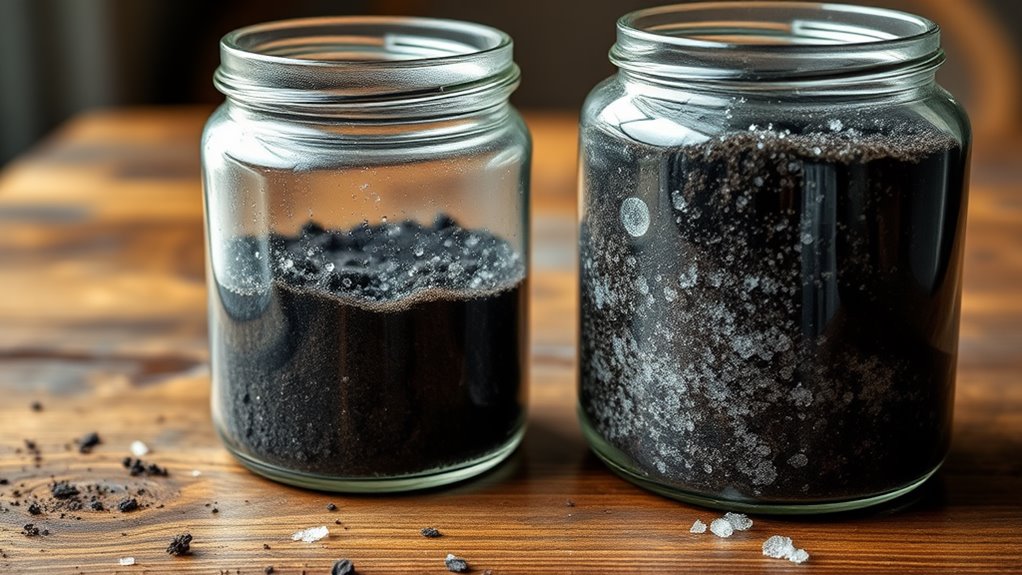DIY Soil Test You Can Do With Vinegar and Baking Soda
To test your soil’s pH at home, you’ll need distilled water, a clean glass jar, pH strips, baking soda, vinegar, and a notebook. Start by collecting a representative sample from your garden, mix it well, air-dry it, then sift out debris. For the vinegar test, add two tablespoons to a tablespoon of soil; vigorous fizzing means alkaline soil. For baking soda, moisten soil and add a teaspoon; fizzing indicates acidic soil. No reaction suggests neutral pH. Use these insights to amend your soil, and discover full procedures in the sections ahead.
Materials Needed
To test your soil at home, you’ll need a few essential items: distilled water for accurate pH readings, a clean glass jar for mixing samples, pH test strips for measuring acidity, baking soda and vinegar for basic reaction tests, and a notebook to record results. For effective homemade soil testing, you select these tools to guarantee reliable pH assessment and reaction checks, minimizing errors in your backyard analysis. Always prioritize precision in your setup. Additionally, understanding soil pH testing is crucial for determining the suitability of your soil for various plants.
Soil Sample Preparation
With your materials assembled, begin soil sample preparation by collecting a representative sample from various garden spots.
Use a clean trowel to dig 6 inches deep, avoiding disturbed areas.
Thoroughly mix the soil in a bucket, then air-dry it on a flat surface until crumbly.
Sift through a fine mesh to remove debris and large particles, ensuring a uniform, uncontaminated mixture for reliable testing. This process is crucial for achieving optimal conditions that support healthy plant growth.
Vinegar Test Procedure
The vinegar test offers a simple way to assess your soil’s pH.
Take your prepared soil sample and place about one tablespoon in a clean container.
Add two tablespoons of white vinegar directly to the soil.
If it fizzes vigorously, you’re dealing with alkaline soil (pH above 7).
No reaction indicates acidic or neutral soil.
For accurate results, use room-temperature vinegar and observe immediately. Additionally, understanding soil pH levels can help you make informed decisions about necessary amendments for your garden’s health.
Baking Soda Test Procedure
You prepare your soil sample by collecting a small amount from your garden and moistening it slightly for accurate testing. Then, you add a teaspoon of baking soda to the sample and mix it thoroughly. Finally, you observe the reaction, noting any fizzing or bubbling that indicates the soil’s pH level. Proper soil preparation is crucial for optimal growth and health of your plants.
Prepare Soil Sample
To begin preparing your soil sample for the Baking Soda Test, collect a representative portion from the desired area.
Aim for approximately one cup of soil, mix it thoroughly, and remove any large particles for reliable test outcomes.
- Feel the excitement of engaging in real science right in your backyard.
- Discover a sense of accomplishment as you handle the soil with care.
- Let this simple step spark your enthusiasm for understanding your garden’s needs.
Add Baking Soda
Now, incorporate baking soda into your prepared soil sample to test for acidity.
Measure exactly one-half cup of baking soda and add it directly to the soil in your container.
Stir the mixture thoroughly with a spoon, ensuring even coverage across the sample.
Use gentle but consistent motions to distribute it uniformly, promoting accurate interaction with soil particles.
Observe Reaction
Examine the soil-baking soda mixture closely for immediate fizzing or bubbling, which signals acidic conditions in the soil.
Look for the reaction’s intensity; strong fizzing indicates high acidity, while none suggests neutral or alkaline soil, guiding your gardening decisions precisely.
- You’ll feel a thrill of discovery as bubbles reveal your soil’s hidden acidity.
- Experience the satisfaction of empowering your green thumb with simple science.
- Let this spark your excitement for nurturing a vibrant, healthy garden.
Understanding the Results
You observe the reaction in your baking soda test to analyze its intensity, which signals the soil’s pH characteristics. This analysis reveals whether your soil leans acidic or alkaline based on the fizzing response. You’ll use these pH insights to adjust your soil for ideal plant growth. Understanding your soil’s pH characteristics is crucial for determining the necessary amendments to create a thriving garden.
Reaction Analysis
Analyzing soil test reactions helps you pinpoint key properties like pH and nutrient levels based on visible changes, such as color shifts or effervescence.
By observing these reactions closely, you’ll accurately interpret soil behavior for effective gardening.
- You’ll feel thrilled as effervescence reveals your soil’s lively carbonates, sparking curiosity.
- Experience empowerment when color shifts expose nutrient dynamics, fueling your confidence.
- Find joy in precise reactions that highlight soil fertility, igniting passion for your garden’s success.
Soil Ph Insights
Soil pH results from your DIY test reveal whether your soil is acidic (below 7), neutral (around 7), or alkaline (above 7), directly influencing nutrient availability and plant growth.
If it fizzes with vinegar, you’ve got alkaline soil; with baking soda, acidic soil. No reaction indicates neutral pH.
Use this information to amend your soil, ensuring plants thrive in the right conditions.
Next Steps for Your Garden
After completing your soil test, evaluate the results to guide amendments and planting choices.
Based on pH levels, add lime to raise acidic soil or sulfur to lower alkaline soil, fostering nutrient availability and robust plant health.
- Feel empowered as you transform your garden into a thriving ecosystem, turning test insights into visible success.
- Experience the joy of selecting plants that flourish in your optimized soil, creating a personal haven of growth.
- Cherish the satisfaction of a bountiful harvest, knowing your efforts have nurtured nature’s bounty effectively.

